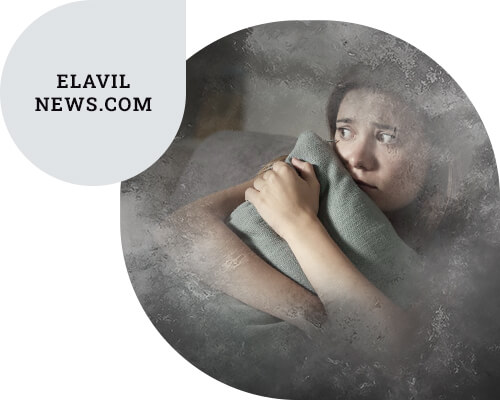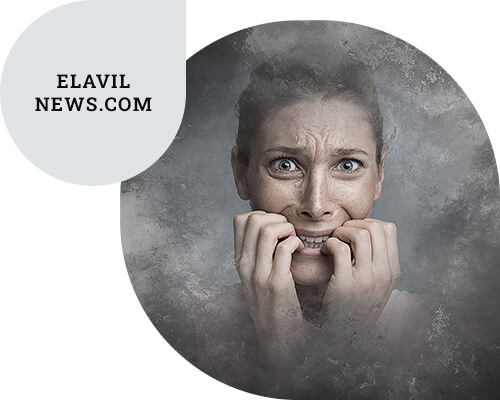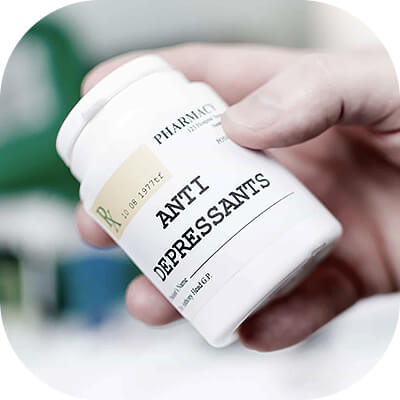What is an anxiety disorder
A person throughout life is affected by a variety of anxieties. As a rule, they are a reaction to stressful situations occurring at home, at work and so on. However, we can speak of an anxiety disorder as a disease only in cases where systematic anxiety significantly affects a person's quality of life, forcing him to adjust his lifestyle.
The symptoms of anxiety disorders are extremely peculiar and depend on the type of the disease. To date, generalized disorder and adaptive disorder, which has an anxiety buildup, are distinguished. Generalized anxiety disorder is characterized by constant excessive anxiety, which envelops the patient in almost any situation, even the most mundane. In turn, people with adaptive anxiety disorder have difficulty adapting to stressful situations. Constant fear, worry, tension and anxiety in this disorder can affect the functioning of various organs and systems: the person may be subject to palpitations, shortness of breath, "nervous" stomach and so on.
Causes of anxiety disorder
The causes of anxiety disorders are explained by several theories from a biological and psychological point of view.
Biological theories. According to these theories, the disorder is explained as some kind of biological abnormality caused by certain changes in the body. The most popular version of the emergence of anxiety disorders is an increase in the production of neurotransmitters.

We should not rule out the possibility that it is the bluetongue that is responsible for the resulting symptoms of the disease. It is located in the brain, namely in the brain stem, and with electrical stimulation causes anxiety, fear. Propranolol, clonidine and benzodiazepines are the medicines which reduce the activity of locus coeruleus and consequently reduce anxiety. In turn, drugs like yohimbine increase anxiety.
Psychological theories. From a psychoanalytic perspective, anxiety is a manifestation that signals the presence of a forbidden need or a certain impulse that needs to be concealed, to prevent the expression of the need. According to this theory, the symptomatology of anxiety disorders is explained as the containment of an unacceptable need within oneself.
Phobias and anxiety in general are viewed in behaviorist terms as reflex reactions to the sudden or anticipated appearance of frightening or painful stimuli. The brain becomes accustomed to this response and soon anxiety begins to occur whether or not there is a stimulus.
More recently, cognitive psychology has emphasized erroneous and distorted thought patterns that precede the onset of anxiety symptoms. For example, in anxiety disorders, patients may react panickedly to seemingly standard everyday sensations and ailments (heart palpitations, mild headaches). As a result, the fear intensifies, and over time escalates and leads to a powerful panic attack. In domestic medicine, anxiety disorders are classified in a group of functional neuroses (a more modern name - neurotic disorders). According to traditional classification, the disease is classified as psychogenically conditioned, which are characterized by awareness of the illness, a variety of symptoms and manifestations, and the complete absence of changes in consciousness.
Symptoms of anxiety disorder
The symptomatology of the disease is extremely extensive. Depending on the type of anxiety symptoms according to the ICD-10, the following symptoms are distinguished:
Anxiety-phobic adjustment disorders are distinguished:
- Obsessive-compulsive disorder;
- Panic disorder;
- Post-traumatic stress disorder.
- Anxiety-phobic disorder.
- A response to acute systematic stress;
- Obsessive-compulsive disorders;
- Anxiety-depressive disorder;
- Generalized anxiety disorder;
- Panic disorder.
Panic disorder. The main sign is panic attacks, which are periodically recurring, occurring in the form of discomfort and sudden fear. Symptoms of this condition are as follows: fear of death, fear of becoming insane, increased sweating, trembling, chest pain, shortness of breath, choking, palpitations, dizziness. Panic attacks usually last around 10-20 minutes. Patients often think they are overcome by a heart attack.
Each subsequent attack intensifies the fears and anxieties, to which is also added another fear - the fear of the next attack. Patients are more afraid, not of the attack itself, but of the fact that it will occur at an inopportune moment or in places where it will be difficult to help them. For this reason, patients start avoiding places with large concentrations of people and absolutely deserted places. They stop walking alone and try not to leave the house at all. This phenomenon, which significantly reduces the quality of life, is known to science as Agoraphobia.

Some patients struggle with anxiety disorders for many years of their lives because of constant relapses. Others manage to cope with the disorder on their own - suddenly and spontaneously. There is also a third group of people who succumb to panic disorder and become housebound, with this conditional status remaining with them for several years.
Generalized anxiety disorders are characterized by a unique trait. This type of disorder causes anxiety that is not related to any circumstances: situations, location, and so on. The attacks are unfixed and occur anytime, anywhere.
Anxiety disorder is diagnosed only when the symptoms of the disease have been haunting the patient for at least 2-3 weeks. The most popular of the symptoms are:
- Fidgeting, shaking, headaches, inability to relax and other types of motor tension;
- Difficulty concentrating, constant worrying, worrying about potential setbacks, and other fears;
- Dry mouth, epigastric discomfort, tachypnea, tachycardia, sweating, dizziness, and other autonomic hyperactivity.
Specialists start talking about mixed anxiety and depressive disorders when depression and anxiety are inherent to the patient, but they are expressed to a medium degree - not pronounced enough to determine the diagnosis.
In these conditions, diagnosis is quite problematic because of the insufficiently pronounced symptoms. The diagnosis of Panic Disorder in this case is more of a method of exclusion. In generalized anxiety disorder, the symptoms are of mild to medium intensity, the anxiety takes on an indefinite character, but it is constant. This is the main difference between this disorder and panic disorder, in which attacks of excessively high intensity occur.
Generalized anxiety disorder is also called "free-floating". It is explained by internal tension, feelings of threat or potential unhappiness that arise from certain situations and conflicts of minor magnitude. These situations have increasingly dire consequences in the eyes of patients, and patients begin to see all problems as unresolvable. It is not uncommon for excessive aggression to be added to the anxiety. This disease negatively affects the musculoskeletal and autonomic-endocrine systems.
Most researchers agree that generalized anxiety disorder - it is not an independent disease, but rather a phenomenon of anxiety expressed in other diseases. For example, in its manifestation, this disorder resembles anxiety of expectation, which is a distinctive feature of panic disorder. However, unlike the same panic disorder, vegetative manifestations are involved to a lesser extent, with the prognosis of generalized anxiety disorder being more optimistic, and the disease itself takes off more smoothly, gradually. As for the symptoms, they are not clonic, as in panic disorder, but tonic. Despite these differences between the two types of the disease, the first disease can lead to the second, and the second can lead to the first.
Social phobia is one of the manifestations of anxiety disorders. This phobia is expressed as an excessive fear of experiencing embarrassment or humiliation in front of others, even strangers. This makes patients avoid places where groups of people congregate, as well as public speaking, being in large companies and so on. As a rule, social phobia implies significant restrictions in the life activities of the patient, and this often leads the patient to the next stage - Agoraphobia.
A simple phobia is expressed by an excessive fear of specific situations, objects, creatures, and so on. Examples of phobias are extremely numerous: fear of heights, pets, snakes, airplanes, elevators, and so on. The patient always experiences trembling, terror, heart palpitations and increased sweating when encountering the object of fear.
Obsessive-compulsive disorder is manifested by a combination of compulsivity and obsessive compulsions. The latter is characterized by persistent impulses, thoughts, or ideas, usually perceived senselessly. For example, thoughts of selling T-shirts, blasphemous thoughts, and so on. Patients are aware of the meaninglessness of these thoughts, but are unable to cope with this inner zeal. As for compulsiveness, it is more of a reaction to the intrusive thoughts that have arisen, aimed at neutralizing them and, consequently, at achieving psychological comfort. However, this behavior is nonsensical, and along with it, completely irrational.

Obsessive-compulsive disorders are of several types. The most common is known as a fear of dirt. Thoughts about contamination lead to patients trying to be in the cleanest possible places, and spending almost 2-3 hours a day washing. Also a fairly popular type of obsessive-compulsive disorder is compulsive checking. Patients are always checking several times at a time to see if the iron is off, the gas is on, the door is closed, and so on. Generally speaking, compulsive behavior somewhat resembles excessive eating, drinking, increased sexuality, and gambling, but in the case of this disorder, the resulting thoughts and behaviors are always unpleasant for the patient.
Post-traumatic stress disorder is an illness that occurs after car accidents, rape, beatings, war and other powerful physical or psychological trauma. Patients tend to relive what happened repeatedly, replaying the unfavorable situation in their minds. Memories may appear both in everyday activities and at night in the form of nightmares. The patient is subjected to a mental stupor, becomes passive, does not experience positive emotions, loses interest in work or hobbies. Post-traumatic stress also leads to overexcitation which is expressed by excessive fearfulness, nightmares, insomnia.
Post-traumatic stress disorder is subdivided into three groups, depending on the degree of severity. The first stage is a completely adequate reaction to trauma, which is expressed in maximal concentration on what has happened. The patient is seized by anxiety. The second stage occurs about a month after the incident, if the person still suppresses memories of what has happened. At this stage, nightmares intensify, there is little emotional expression, and feelings of helplessness continue to increase. The third and final stage is collapse of the spirit and complete demoralization, loss of meaning in life and despair.
In anxiety disorders, patients focus as much as possible on their shortcomings and cannot adequately form an evaluation of themselves. As a result, people become withdrawn and insecure, and only start new acquaintances and relationships when they know for sure that they will not be rejected. Rejection, as well as the loss of the existing one, is a strong moral blow for patients, therefore they prefer not to take risks and do not get into relationships with people.
However, loneliness is not the answer!
The symptomatology of anxiety disorders is multifaceted and varied. The main symptoms of the disorder include:
- Avoidance of relationships with new people;
- Desire for a relationship with society, bordering on extreme shyness;
- Self-isolation from society;
- High sensitivity to rejection, criticism;
- Disgust for the own person;
- Extremely low self-esteem;
- Feelings of own inferiority;
- A desire to avoid physical contact;
- Shyness and embarrassment can be caused by the slightest of preconditions;
- Lack of desire for intimacy;
- Shyness, modesty in unreasonable limits;
- Confidence only in oneself;
- Excessive self-criticism;
- Feeling of loneliness;
- Feeling of one's own inferiority in comparison to others;
- Chemical and mental dependence.
Diagnosis of Anxiety Disorder
The presence of the above symptoms does not yet indicate illness. The diagnosis must be made by a psychiatrist, and in order for a specialist to recognize the problem and confirm the presence of the disease, the anxiety disorder symptoms must bother the patient for at least 2-3 weeks.
The diagnosis of Anxiety Disorder is not difficult to diagnose. But the type of anxiety disorder is quite problematic to identify. The reason for this is that the symptoms are similar for different types of the disorder. To identify its type and degree allows the analysis of the places and times of occurrence of symptoms. And in general, the depression and anxiety scale, the Spielberger-Hanin test, the personality anxiety scale and many others are used in the diagnosis of anxiety disorder.
When an anxiety disorder is suspected, you need to pull yourself together, adequately assess the situation, and try to answer a few questions for yourself:
- Are there feelings of fear and anxiety, autonomic regulation problems and sleep disturbances;
- How long the symptoms continue to bother you;
- Whether the symptoms may be related to organic diseases. It's best to visit a doctor and have your health checked;
- Whether there is any systematic pattern in the onset of symptoms (occur in a certain place, under certain conditions, at a particular time, and so on).
Anxiety Disorder Treatment
Anxiety disorders are treated with medication therapy and rational persuasion or a combination of both. Supportive psychotherapy will help to sort out the factors that influence the anxiety disorder and eventually cope with them. Meditation and relaxation can also help reduce anxiety. For overly fidgety patients and people with a lot of muscle tension, there are perfectly safe medications to help manage these symptoms and sleep well. Smoking, caffeine and alcohol should be completely avoided: they increase anxiety. In the case where you are already taking medication for anxiety disorders, be sure to consult with your doctor when it became necessary to use other medications or alcoholic beverages. In each case, the treatment plan is different, individualized. Therefore, it is better to consult a specialist than later try to overcome irreversible consequences.
Anxiety disorders as a disease rarely go away when they are left to their own devices. More often, they escalate into something more: depression, a severe generalized form of illness, internal diseases, hypertension, ulcers, and so on.
Psychotherapy is the foundation of anxiety disorder treatment. Through this method of treatment, the doctor, first of all, learns the causes of the disease and then teaches the patient ways to control himself and his unusual condition. Thanks to the unique techniques, sensitivity to provoking factors is significantly reduced and the patient has an overwhelming desire to cope with the disease. This desire is an essential component of successful treatment.
Tranquilizers, antidepressants and adrenoblockers can be prescribed as medications.
Adrenoblockers allow you to cope with symptoms on the autonomic side (blood pressure, heart palpitations). Tranquilizers relieve muscle tension, normalize sleep, and significantly reduce feelings of fear and anxiety. However, medications of this group are addictive, so they are prescribed, as a rule, a short course and only in acute need. You should also be very careful when taking tranquilizers: drinking alcohol together with these drugs can lead to complete respiratory failure. Their use is not recommended for patients with professions requiring increased attention.
With drug treatment, antidepressants are most often prescribed. They do not cause dependence, so they can be prescribed with a long course. The mechanism of action of this profile of drugs is directed at the progressive effect: within a few days or even weeks, the effectiveness of treatment "speeds up". After a while, the patient feels a significant easing of fear and anxiety. The drug also helps with vegetative disorders and is prescribed for chronic pain.
If you have an anxiety disorder, you need to see a psychologist.
By: Dr. Anna Fishzon











